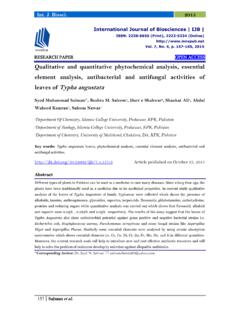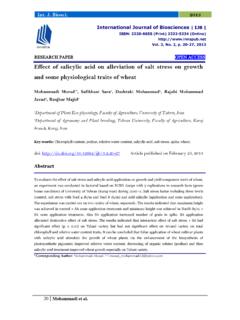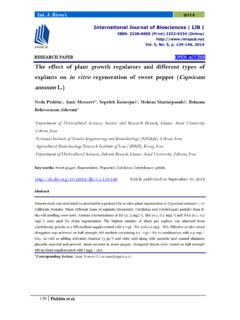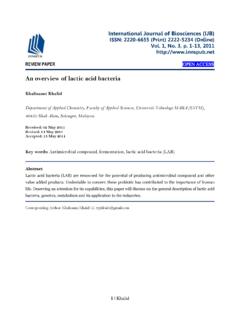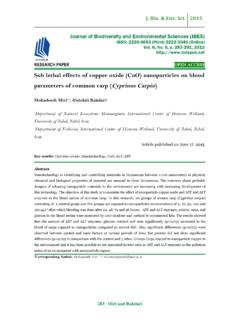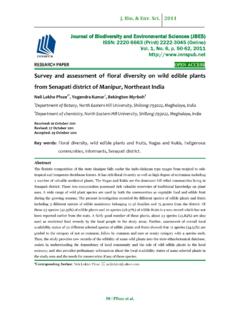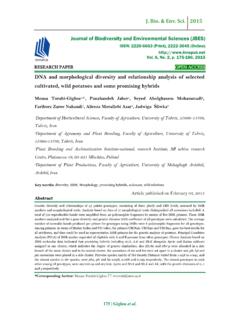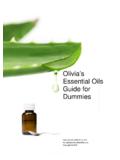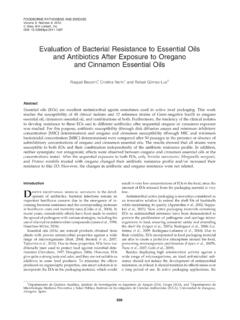Transcription of Allelopathic effect of some essential oils on seed ...
1 J. Bio. & Env. Sci. 2013 67 | Rahimi et al. RESEARCH PAPER OPEN ACCESS Allelopathic effect of some essential oils on seed germination of Lathyrus annuus and Vicia villosa Abdol Rahman Rahimi1*, Seyyed Javad Mousavizadeh2, Haydeh Mohammadi3, Asad Rokhzadi3, Mohammad Majidi4, Sheno Amini1 1 Young Researchers and Elites Club, Sanandaj Branch, Islamic Azad University, Sanandaj, Iran 2 Young Researchers Club, Rasht Branch, Islamic Azad University Rasht, Iran 3 Department of Agronomy and Plant Breeding, Sanandaj Branch, Islamic Azad University, Sanandaj, Iran 4 Sanandaj Branch, Islamic Azad University, Sanandaj, Iran Article published on April 25, 2013 Key words: Allelopathic , essential oils , seed germination .
2 Abstract It has been shown that chemicals found in extracts or essential oils of plants have Allelopathic effects on seed germination . Laboratory bioassay was laid out in order to study the inhibitory effects of some essential oils on seed germination of two weeds (Lathyrus annuus and Vicia villosa). The treatments included control (distilled water), ethanol and different concentrations (200, 400, 600 and 800 ppm supplement with ethanol at all) of wild mint (Mentha longifolia), coriander (Coriandrum sativum L.), fennel (Foeniculum vulgare), green cumin (Cuminum cyminum L.) and caraway (Carum carvi L.) essential oils . Results showed that both ethanol and essential oils prevented seed germination of Vicia villosa, and Inconsiderable rates of germination ( %) were observed only by ethanol and low concentrations of essential oils .
3 Also all essential oils and ethanol decreased Lathyrus annuus germination compared with control. All essential oils except for the fennel essential oil were more effective on inhibiting Lathyrus annuus germination than ethanol. Moreover, radicle growth was stopped after 7 days and seedlings were did not appear at treated seed for both species. The germination percentage at untreated seeds of Vica villosa and Lathyrus annus was and 80%, respectively. *Corresponding Author: Abdol Rahman Rahimi Journal of Biodiversity and Environmental Sciences (JBES) ISSN: 2220-6663 (Print) 2222-3045 (Online) Vol. 3, No. 4, p. 67-73, 2013 J. Bio. & Env. Sci. 2013 68 | Rahimi et al. Introduction Weeds are a serious pest that damages most of the crops and are eternal problem for agriculture.
4 Also in fields, weeds compete with crops for growth factors such as light, moisture and nutrient elements. So, a weed impresses crops in all directions and reduces the quality and quantity of the agricultural product, as well as increase the cost of production (Samad et al., 2008). Weed management with chemical methods like the synthetic herbicides although is effective but their continuous and excessive use will be associated with resistance of weeds to herbicides (Bhowmik and Inderjit, 2003; Ismail et al., 2012). Moreover, the risk of residual herbicides in agricultural products and foods and contamination of soil and groundwater with herbicides are serious threat to the environment and human health (Jamil et al.)
5 , 2009; Kordali et al., 2007). Therefore, seeking to obtain suitable natural compounds as a safe alternative source is essential for weeds management and for circumvention of the bio-environmental problems induced by synthetic herbicides. One of the possible solutions is allelopathy. Allelopathy is an interference mechanism which plants release chemical compounds and they have effect on other plants (Gholami et al., 2011). The role of allelopathy as interactions of plant to plant and especially its potential for weed management in agricultere are consedriable (Kolahi et al., 2009). essential oils which are one of the natural compounds from a number of higher plants are used as medicinal, antimicrobial, antioxidant substances, etc.
6 (Omidbaigi, 2005). Recent experiments show that secondary metabolites and chemical compounds existing in extracts or essential oils of some plants have Allelopathic effects on seed germination and seedling growth in tested plants (Romagni et al., 2000; De Feo et al., 2002; Abrahim et al., 2003; Kordali et al., 2007; Paudel and Gupta, 2008; Ramezani et al., 2009; Brito et al., 2010; Ismail et al., 2012; Rassaeifar et al., 2013). Because of possible use of essential oils as natural herbicide in weed controlling, they may be considered as valuable alternatives in organic farming. In order to achieve efficient and reliable plant sources in weed controlling, the Allelopathic potential of different plants or essential oils should be tested on various plant species.
7 In this area, the available data about some weeds including Lathyrus annuus and Vicia villosa are scarce. Thus, in this context we have investigated the Allelopathic effects of wild mint (Mentha longifolia), coriander (Coriandrum sativum L.), fennel (Foeniculum vulgare), caraway (Carum carvi) and green cumin (Cuminum cyminum L.) essential oils against germination of Lathyrus annuus and Vicia villosa with a view to explore them as a bioherbicide for weed management. Material and methods Plant material A laboratory experiment was conducted at Islamic Azad University, Sanandaj Branch, Kurdistan, Iran. Seeds of Lathyrus annuus and Vicia villosa were obtained from a Sanandaj landrace in Kurdistan, Iran. The essential oils were extracted from a fresh leaves of wild mint and dry seeds of coriander, fennel, green cumin and caraway by hydro-distillation using the Clevenger.
8 Treatment setting The treatments included control (distilled water), ethanol % and concentrations of 200, 400, 600 and 800ppm of wild mint, coriander, fennel, caraway and green cumin essential oils . essential oils were dissolved in ethanol and were prepared at foresaid concentrations with % ethanol at all concentrations. germination Test Fifteen seeds of each species were placed on a filter paper in Petri dishes. Twenty milliliters from each test solution (distilled water or ethanol % or essential oils ) separately were applied to each J. Bio. & Env. Sci. 2013 69 | Rahimi et al. replicate for each treatment. All experiments were carried out at 20 1 C, relative humidity of 55-65% and 16-h light/8-h dark photoperiod in incubator condition.
9 The number of germinated seeds was recorded every day for the time necessary to achieve the final number of germinated seeds. Seeds were observed daily and considered germinated when the radicle was approximately 1 mm long or more and the percentage of germination was calculated as follows: GP=100Nn Where: GP = germination percentage, n = number of seeds germinated, N = total number of seeds. Statistical analysis The experiment was established in a factorial lay out based on completely randomized design with three replications. Data were analyzed using SAS software (2001) and the comparison of means were done by Duncan test (P< ). Results Vicia villosa The obtained results indicated that Vicia villosa germination effectively affected by essential oils and ethanol.
10 All essential oils and ethanol significantly inhibited seed germination at Vicia villosa (Fig. 1). Fennel essential oil completely suppressed Vicia villosa germination and inconsiderable germination ( %) was observed only by ethanol and low concentrations of other essential oils (200 and 400ppm of green cumin and 200ppm of wild mint, caraway and coriander). In high concentrations of essential oils there was not any germinated seed, while the highest germination ( ) was obtained by control (Table 1). Maximum radicle length was 4 millimeter and its growth was stopped after 7 days. Moreover seedlings were not appeared at any one of the treated seeds, while at control treatment both radicle and seedling growth occur normally (data not shown).

